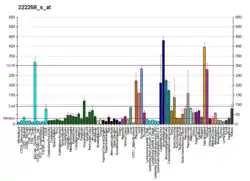SH3BP4
SH3 domain-binding protein 4 is a protein that in humans is encoded by the SH3BP4 gene.[5][6]
This gene encodes a protein with 3 Asn-Pro-Phe (NPF) motifs, an SH3 domain, a PXXP motif, a bipartite nuclear targeting signal, and a tyrosine phosphorylation site. This protein is involved in cargo-specific control of clathrin-mediated endocytosis, specifically controlling the internalization of a specific protein receptor.[6]
References
- GRCh38: Ensembl release 89: ENSG00000130147 - Ensembl, May 2017
- GRCm38: Ensembl release 89: ENSMUSG00000036206 - Ensembl, May 2017
- "Human PubMed Reference:". National Center for Biotechnology Information, U.S. National Library of Medicine.
- "Mouse PubMed Reference:". National Center for Biotechnology Information, U.S. National Library of Medicine.
- Dunlevy JR, Berryhill BL, Vergnes JP, SundarRaj N, Hassell JR (Mar 2000). "Cloning, chromosomal localization, and characterization of cDNA from a novel gene, SH3BP4, expressed by human corneal fibroblasts". Genomics. 62 (3): 519–24. doi:10.1006/geno.1999.5994. PMID 10644451.
- "Entrez Gene: SH3BP4 SH3-domain binding protein 4".
Further reading
- Wong WT, Schumacher C, Salcini AE, et al. (1995). "A protein-binding domain, EH, identified in the receptor tyrosine kinase substrate Eps15 and conserved in evolution". Proc. Natl. Acad. Sci. U.S.A. 92 (21): 9530–4. doi:10.1073/pnas.92.21.9530. PMC 40835. PMID 7568168.
- Salcini AE, Confalonieri S, Doria M, et al. (1997). "Binding specificity and in vivo targets of the EH domain, a novel protein-protein interaction module". Genes Dev. 11 (17): 2239–49. doi:10.1101/gad.11.17.2239. PMC 275390. PMID 9303539.
- Strausberg RL, Feingold EA, Grouse LH, et al. (2003). "Generation and initial analysis of more than 15,000 full-length human and mouse cDNA sequences". Proc. Natl. Acad. Sci. U.S.A. 99 (26): 16899–903. doi:10.1073/pnas.242603899. PMC 139241. PMID 12477932.
- Jin J, Smith FD, Stark C, et al. (2004). "Proteomic, functional, and domain-based analysis of in vivo 14-3-3 binding proteins involved in cytoskeletal regulation and cellular organization". Curr. Biol. 14 (16): 1436–50. doi:10.1016/j.cub.2004.07.051. PMID 15324660. S2CID 2371325.
- Gerhard DS, Wagner L, Feingold EA, et al. (2004). "The status, quality, and expansion of the NIH full-length cDNA project: the Mammalian Gene Collection (MGC)". Genome Res. 14 (10B): 2121–7. doi:10.1101/gr.2596504. PMC 528928. PMID 15489334.
- Khanobdee K, Kolberg JB, Dunlevy JR (2005). "Nuclear and plasma membrane localization of SH3BP4 in retinal pigment epithelial cells". Mol. Vis. 10: 933–42. PMID 15616480.
- Benzinger A, Muster N, Koch HB, et al. (2005). "Targeted proteomic analysis of 14-3-3 sigma, a p53 effector commonly silenced in cancer". Mol. Cell. Proteomics. 4 (6): 785–95. doi:10.1074/mcp.M500021-MCP200. PMID 15778465.
- Hillier LW, Graves TA, Fulton RS, et al. (2005). "Generation and annotation of the DNA sequences of human chromosomes 2 and 4". Nature. 434 (7034): 724–31. doi:10.1038/nature03466. PMID 15815621.
- Tosoni D, Puri C, Confalonieri S, et al. (2006). "TTP specifically regulates the internalization of the transferrin receptor". Cell. 123 (5): 875–88. doi:10.1016/j.cell.2005.10.021. PMID 16325581. S2CID 5809800.
- Beausoleil SA, Villén J, Gerber SA, et al. (2006). "A probability-based approach for high-throughput protein phosphorylation analysis and site localization". Nat. Biotechnol. 24 (10): 1285–92. doi:10.1038/nbt1240. PMID 16964243. S2CID 14294292.
- Ewing RM, Chu P, Elisma F, et al. (2007). "Large-scale mapping of human protein-protein interactions by mass spectrometry". Mol. Syst. Biol. 3 (1): 89. doi:10.1038/msb4100134. PMC 1847948. PMID 17353931.
This article is issued from Wikipedia. The text is licensed under Creative Commons - Attribution - Sharealike. Additional terms may apply for the media files.




